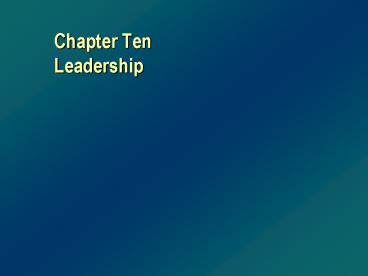Chapter Ten Leadership - PowerPoint PPT Presentation
Title:
Chapter Ten Leadership
Description:
Chapter Ten Leadership – PowerPoint PPT presentation
Number of Views:99
Avg rating:3.0/5.0
Title: Chapter Ten Leadership
1
Chapter TenLeadership
2
Leaders Versus Managers
- A Leader is . . .
- Visionary
- Passionate
- Creative
- Flexible
- Inspiring
- Innovative
- Courageous
- Imaginative
- Experimental
- Independent
- One who shares knowledge
- A Manager is . . .
- Rational
- Consulting
- Persistent
- Problem-solving
- Tough-minded
- Analytical
- Structured
- Deliberative
- Authoritative
- Stabilizing
- One who centralizes knowledge
Source Genevieve Capowski, Anantomy of a
Leader Where Are the Leaders of Tomorrow?,
Management Review, March 1994, p. 12 David
Fagiano, Managers vs. Leaders A Corporate
Fable, Management Review, November 1997, p. 5.
3
What Is Leadership?
- Types of power
- Reward power is the managers ability to
- allocate organizational resources in exchange
- for cooperation.
- Coercive power, sometimes called punishment
power, is the opposite of reward power. - Expert power is based on an individuals
technical or expert knowledge about a particular
area. - Referent power arises from an individuals
personal characteristics that are esteemed by
others. - Personal power consists of both expert and
referent power, or a combination of both.
4
Why Do Employees Respond to Different Types of
Power?
Exhibit 11 . 1
5
Theories of Leadership
- Job-centered and
- employee-centered leader
- behaviors
- Task-oriented leader behaviors
- Job-centered leaders achieved higher worker
productivity. - People-oriented leader behaviors
- Employee-centered leaders create more positive
worker attitudes.
6
Theories of Leadership
- Initiating structure and consideration
- Initiating structure
- Task-oriented leaders insist workers follow rigid
- work methods, use close supervision and
direction, make decision alone, and push workers
for greater efforts. - Consideration
- Relationship-oriented leaders appreciate job well
done, stress high morale, treat workers as
equals, and are friendly and approachable. - Subsequent studies found that leaders who score
high on both behaviors are more effective than
leaders scoring low on these behavioral styles.
7
- Situational leadership theory
- (Hersey-Blanchard)
- Assumptions
- Leaders can and should adjust their behavior to
suit the decision-making situations in the
workplace. - Ready followers require less leadership less
ready followers need more guidance and more
leadership. - Findings
- The best leadership style is the one that best
matches the situation. - Leadership style also depends on the readiness of
followers for independent action.
8
Influence Tactics Used by Leaders
- Setting a good example
- Assertiveness
- Reason and logic
- Ingratiation
- Bargaining
- Coalition formation
- Joking and kidding
9
Characteristics of Effective Leaders
10
Behaviors of Effective Leaders
Adapt to the situation
Provide stable performance
Demand high standards of performance
Provide emotional support
Give frequent feedback
Have a strong customer orientation
Recover quickly from setbacks
Play the role of servant leader
11
Transformational/Transactional Leadership
- Transformational leadership
- An inspirational (charismatic) form of
- leader behavior based on modifying
- followers beliefs, values, and ultimately their
behavior. - Transactional leadership
- Leader behavior that is based on appealing to
followers rational exchange motive (e.g.,
exchanging labor for wages) to help clarify the
path from effort to reward and to focus them on
organizational goals.
12
Emotional Intelligence
- Emotional intelligence (Goleman)
- The set of personal characteristics
- (self-awareness, self-regulation, motivation,
empathy, and social skills) that plays a key role
in leader success by allowing persons to more
effectively manage themselves and their
relationships with others.
13
Qualities of Transformational and Charismatic
Leaders
Possess a vision
Masterful communicators
Inspire trust
Help group members feel capable
Energy and action orientation
Intellectually stimulating
Provide inspiration































